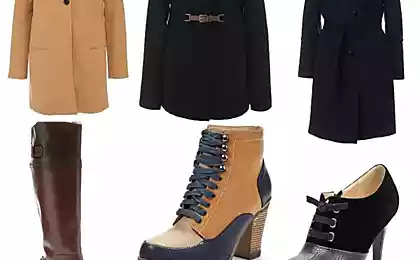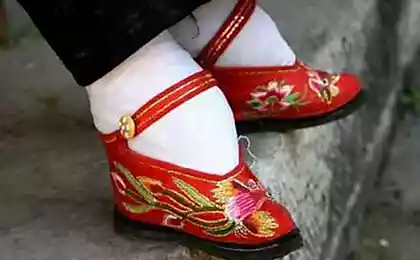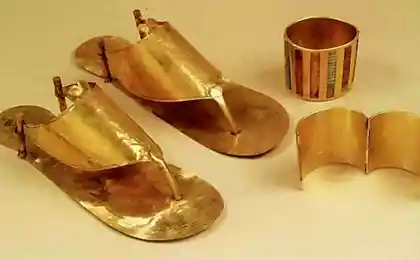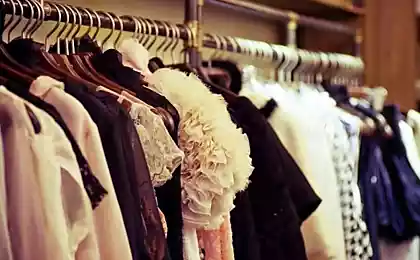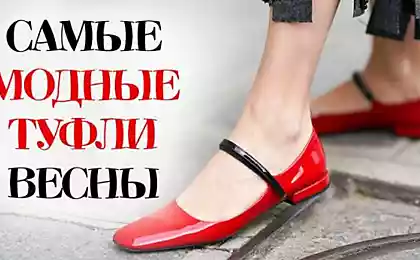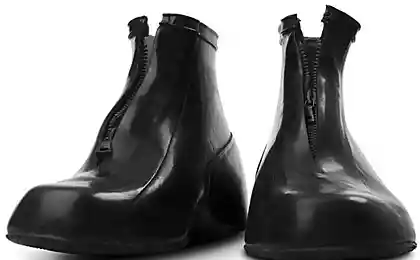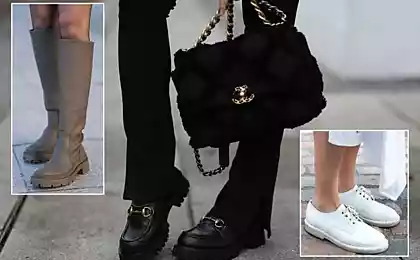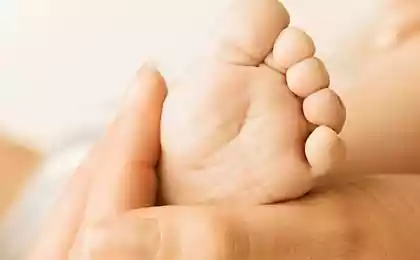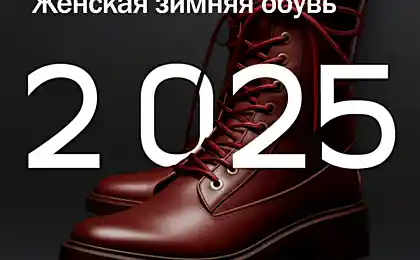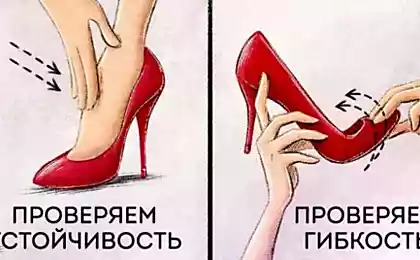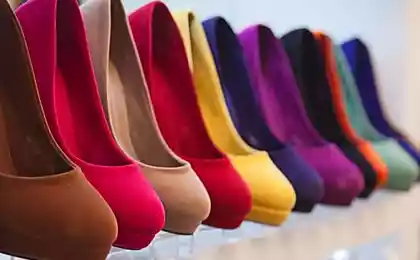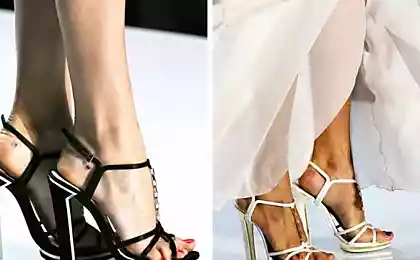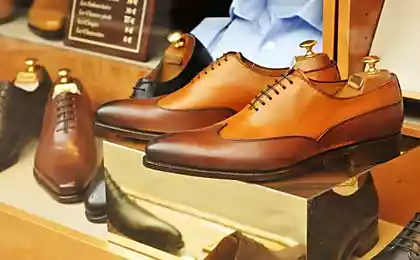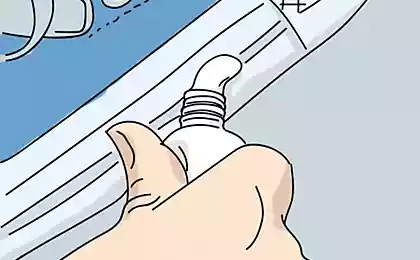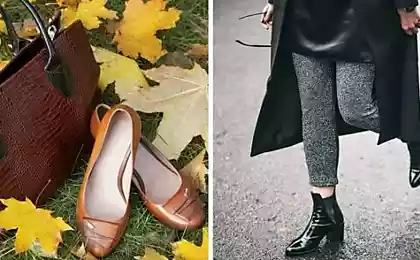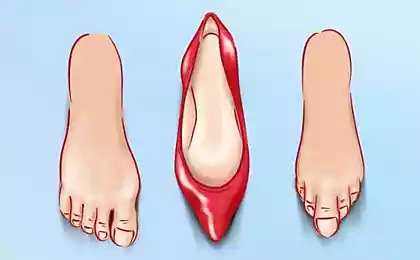11778
History of shoes (37 photos)
It is interesting to know that our ancestors were, where did this name, and who was wearing what.
Cognitive information from the Middle Ages to the XIX century.
Let's go.
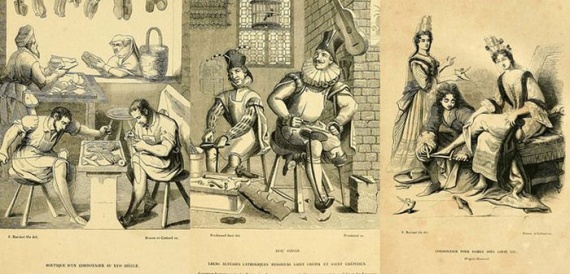
History of shoes more than one millennium. The most reliable information about what kind of shoes worn by our ancestors date back to the existence of ancient Egypt and Greece. At the time there were all sorts of popular sandals that were made so that the shoe can be distinguished representatives of different social classes. In addition, men's and women's shoes vary in color and embroidery and pearl jewelry pointed out that these shoes designed for special occasions.
Medieval Europe has proposed to replace the sandals shoes with long, upturned noses. Since that time, the fashion for shoes easier to follow - from paintings, engravings and illustrations. In addition, the shoes of the time quite well represented in museums.
In the Middle Ages particularly interesting Crakow - shoes with long, upturned noses, which are often decorated with bells or bells.
French King Philip IV even issued a special law under which all the nobles had to wear these shoes only. In the XIV century the length of the shoes showed the nobility of their owner: the nose shoes increased in length, depending on rank. To walk comfortably and not stumble, very long noses bent end shoes tied to the foot of twine. This form of noses shoes persisted even in armor.
Crakow in painting and armor element, exhibited in the museum
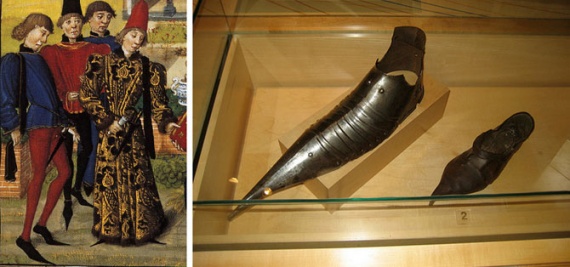
Fragment of the picture and the exhibits of the museum (approximately XIV-XV century)
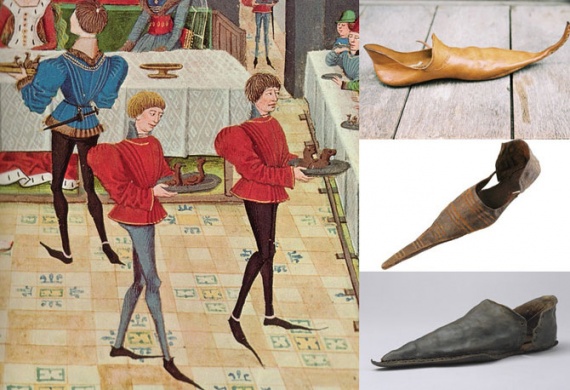
Image on a wooden canvas: Holy Georgy slaying the dragon.
In the Renaissance, shoes made of leather, velvet, silk and wool fabric in different colors. Wore boots and shoes made of soft leather or suede. Externally, the shoes of those times are increasingly approaching the models that we wear today. Shoes decorated with patterned perforations in the manufacture of materials used in different colors.
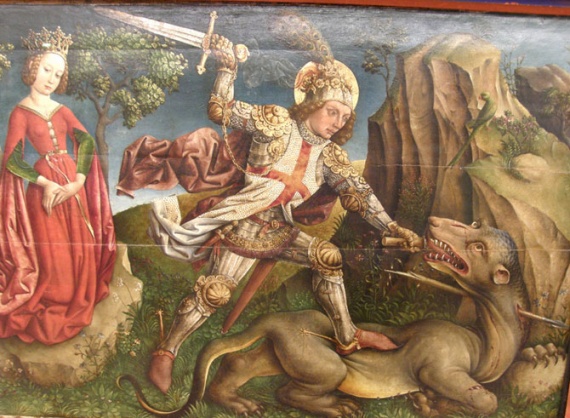
Women's shoes, made in Italy (1605 g)
In the XV century shoes have become more convenient due to the fact that changed, becoming shorter and wider (such models are called "cow snout"). With the increase and expansion of the front of a pair of tapered and decreased back, and in the 20s of the XVI century shoes have become so small that they could hardly stand, and so strings were attached on the rise.
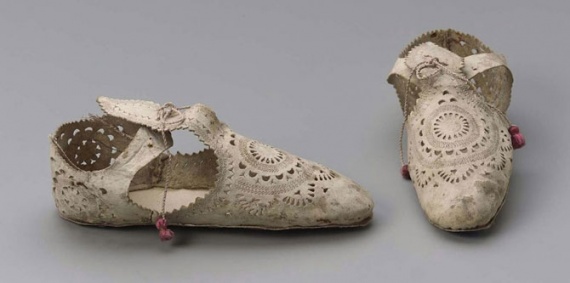
Element of armor; leather shoes made in England (XVI century).
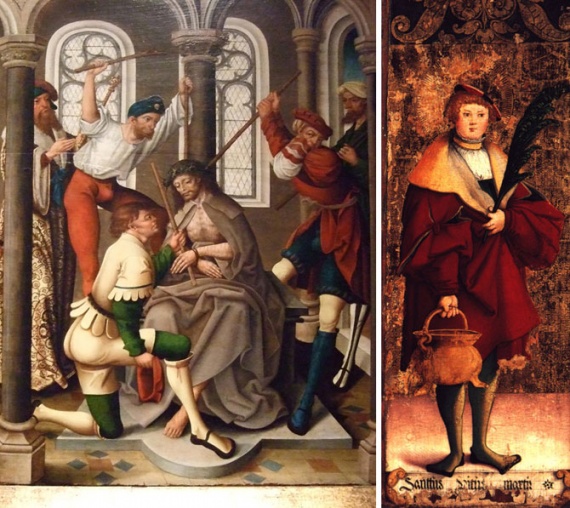
Together with the fashion for numerous sections in a suit, came into vogue "bear paw" - shoes made of colored leather or velvet without heels with broad noses, fashionable in the middle of the XVI century. They are decorated with incisions, through which could be seen lining of a different color.
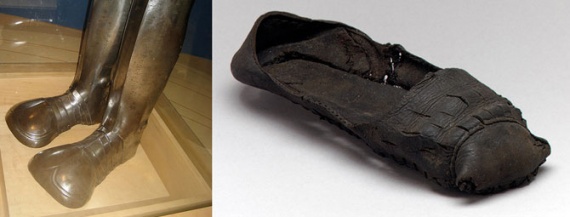
Portrait of Philip II; fragment of the picturesque image.
In the XVII century, in the Baroque era became fashionable heels and bows on shoes. At balls even men had to appear in shoes adorned huge bows ribbons (such bows could be even two, one, more, - on the rise, another, smaller - about the sock). But in all other cases, the life they preferred boots - high boots with square toes, the tops of which ended in wide sockets. They are usually lowered to the knees and worn together with the canons - a kind of leggings and top trimmed with delicate lace.
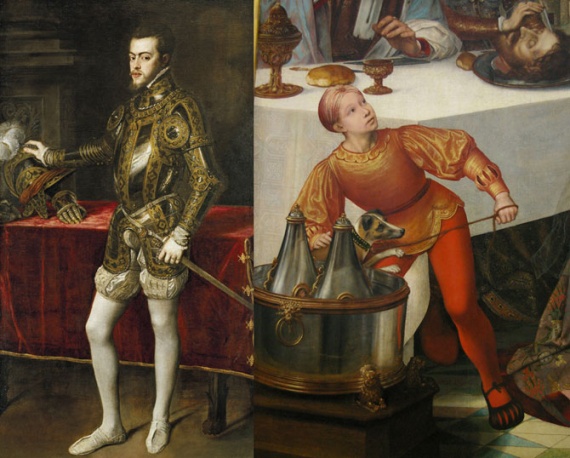
Treads of the museum; picture of Pieter de Hooch "Empty glass».
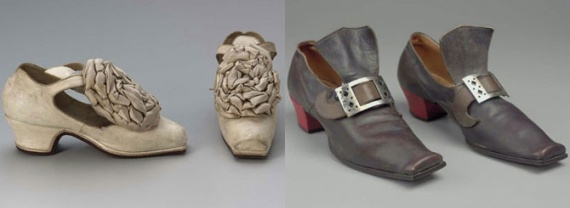
Its limit sole and heel height reached in the XVII century, during the reign of Louis XIV (it is believed that the king, being small in stature, introduced the fashion of high heels deliberately to look taller). High heels red (sometimes even painted exquisite miniatures) came into use long court ladies.
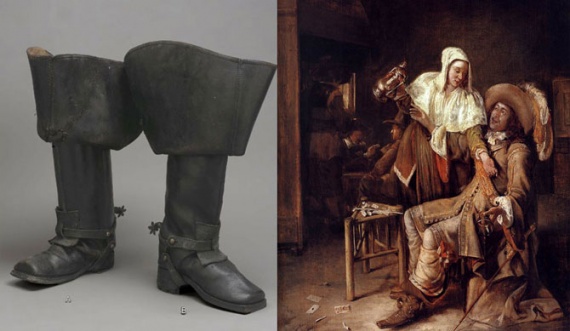
Portraits of Louis XIV, in 1670 and 1701 years.
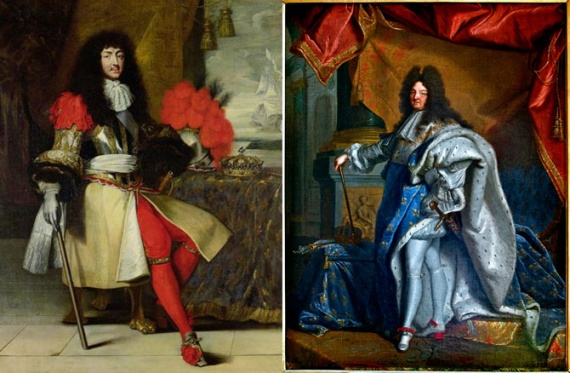
Portraits of men early XVII century.
Ladies wore while graceful, light shoes of velvet, silk and brocade. It is noteworthy that one of the most popular models of steel shoes slap-sole shoes, the idea of which was borrowed from the male wardrobe. Initially, these shoes were male and they were used during riding. Their work was as follows: heel kept the leg in the stirrup, but dismounting, he sank into the earth, that inconvenience. Therefore, to protect the heel and convenience on the shoes worn single sole. Its feature was that while walking she knocked on the heel.
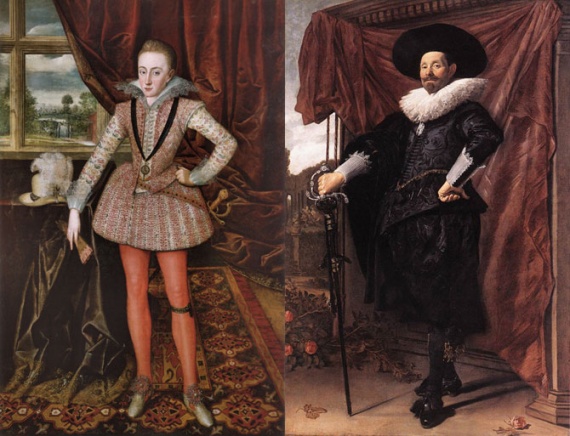
Female portraits early XVII century
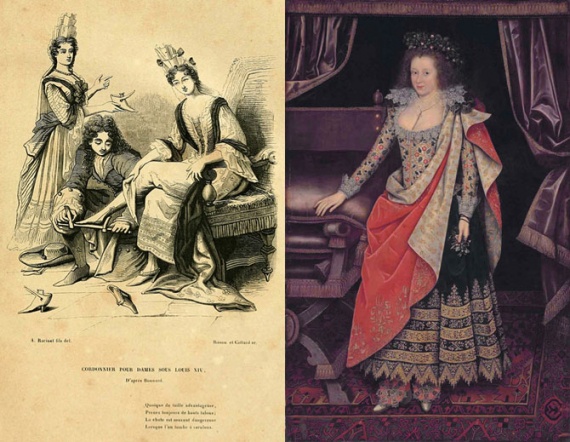
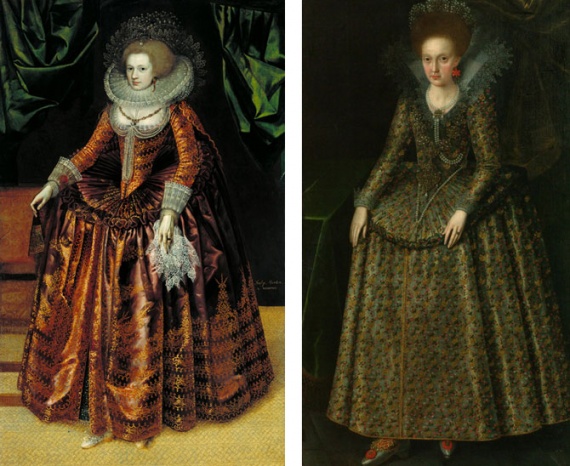
Presumably Italian shoes, about 1670; French shoes made of silk and leather, 1690-1700 gg
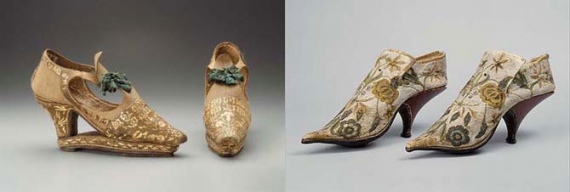
Shoes made in 1651; presumably Italian shoes, 1690-1720 gg

Italian shoes patternami- supports for protection from puddles and mud, 1660s; shoes slap-sole shoes.
In the XVIII century, Rococo, further increasing the value of ornaments and decorations in shoes: buckles, shnurovok and bows. For ladies shoes heel is characteristic of those years in the form of wine glasses and shoes without backs.
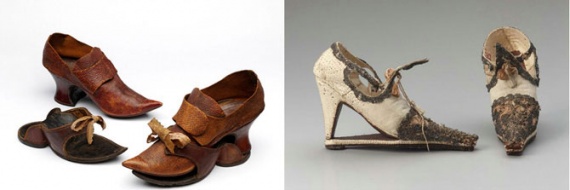
Men's portraits of the first and second half of the XVIII century
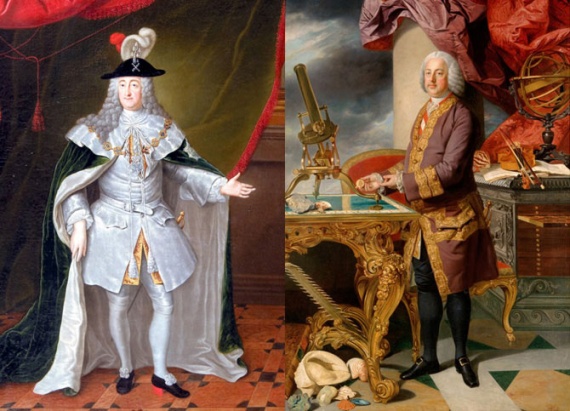
Illustration of the XVIII century; Portrait of a Woman, 1763
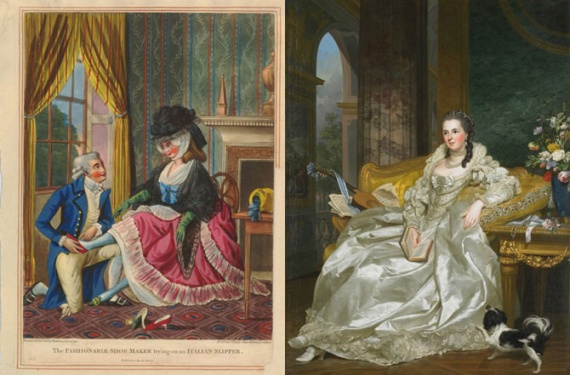
Francois Boucher "Toilet", 1742
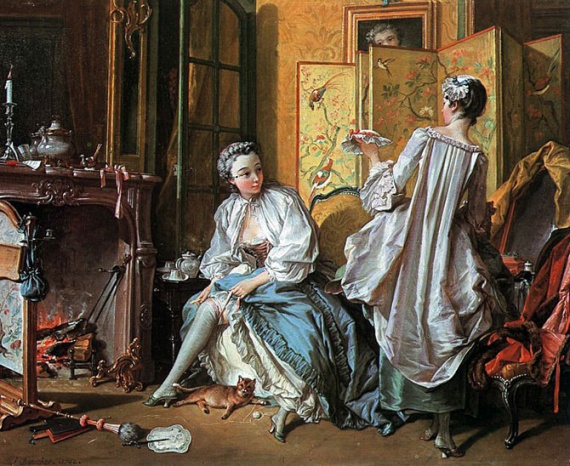
European shoes, years 1750-1760; presumably English shoes, the beginning of the 1730s

French shoes, the beginning of the XVIII century; European shoes, 1780-85 years
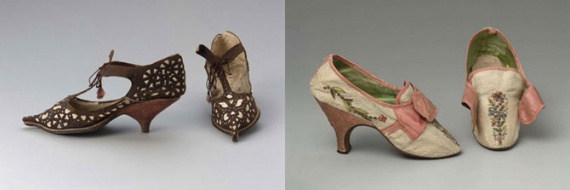
Women's shoes with protective patterns
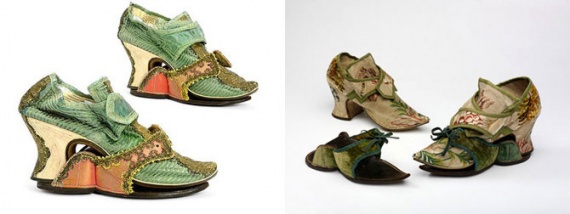
Shoes of the first half of the XVIII century
During and after the Revolution in France in fashion too real revolution took place under the sign of "a return to the ancient costume." It was a kind of protest against the aristocracy. Disappeared heel popularity of multi-colored shoes with ties resembling modern "ballerina" and shoes in the same style. Often shoes decorated with embroidery wool, silk and beads.
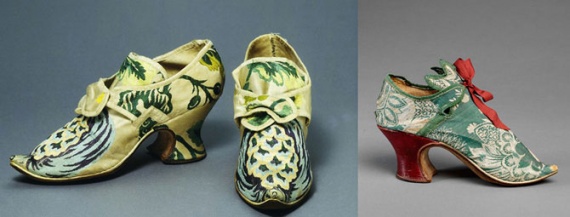
Thomas Lawrence "Portrait of George IV», 1816; Portrait of Louise of Orleans, 1830
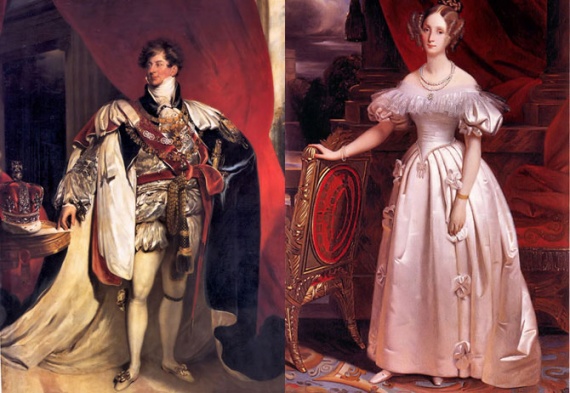
Portrait of Louise Felicite Durfort, 1808; portrait of Barbara Golitsyn, 1792
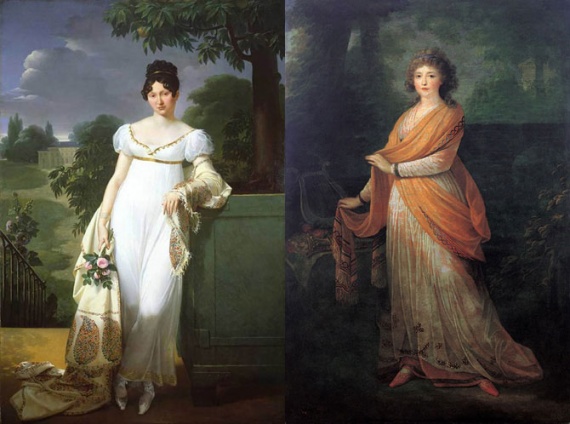
Shoes, 1820; shoes, 1851
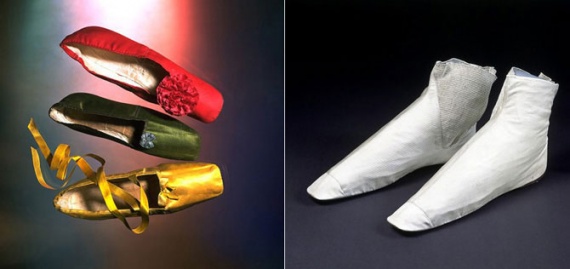
Wedding shoes, 1865; Women's shoes, 1845-1865 gg
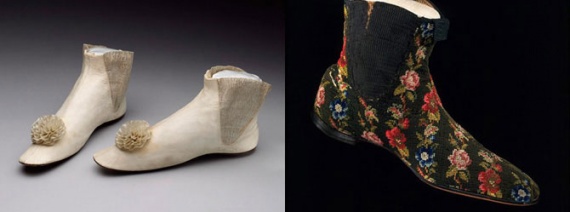
European shoes, 1800; wedding shoes Queen Victoria

"Ancestors" of modern sleepers, made in England, about 1800-1850 years
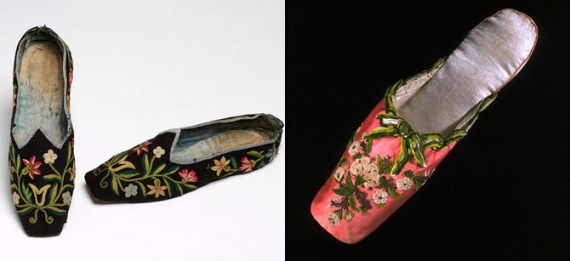
Women's shoes, 1850; Evening Shoes Empress Eugenie
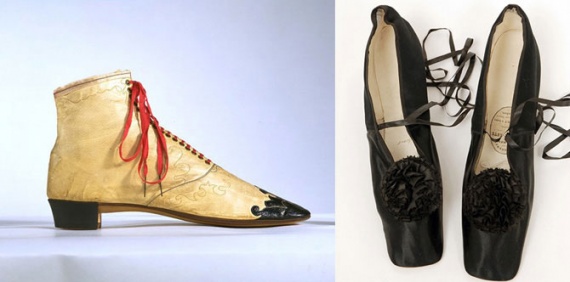
Such shoes made of silk and satin in bad weather on the street needed protection.
With the return of the fashion crinolines, and later - bustles, skirts almost completely closed shoes. From the middle of the XIX century begins to emerge heeled shoes, silk shoes occupy a place convenient and practical leather shoes. The shape of the shoe becomes more rigid, there is lacing and zipper. The most fashionable model of the time - shoes and high boots on kabluchke- "a drink" of medium height with buttons and lacing.

Evening shoes, 1875-85 biennium; wedding shoes, made in 1886

Evening shoes, 1875-85 biennium; women's shoes 1855-1865 gg
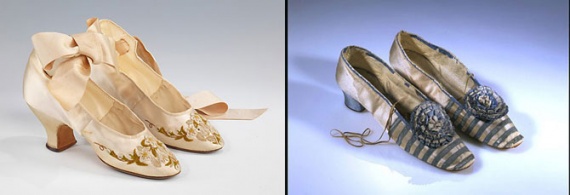
Shoes made in 1900; shoes, 1865-1875 gg
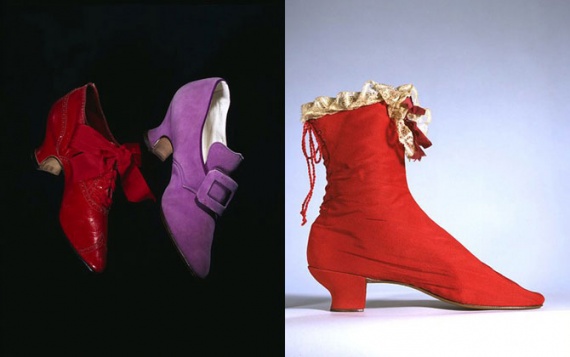
Buttoned boots, 1870-79; boots, 1895-1915 gg
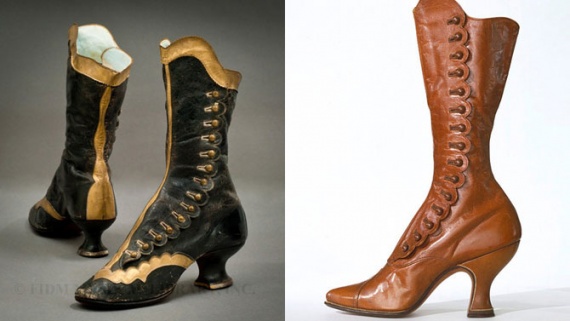
James Tissot "October", 1877; "Breakfast" 1868
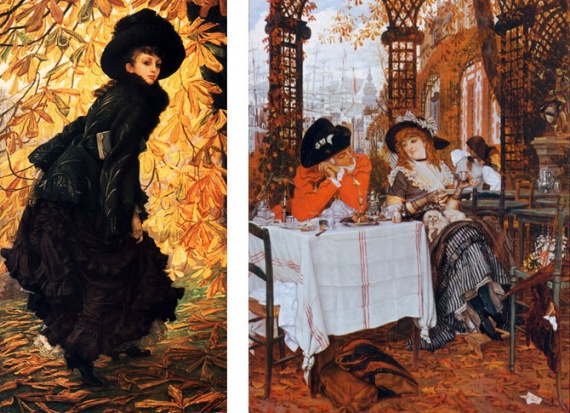
Source: www.izuminki.com Random page
Cognitive information from the Middle Ages to the XIX century.
Let's go.

History of shoes more than one millennium. The most reliable information about what kind of shoes worn by our ancestors date back to the existence of ancient Egypt and Greece. At the time there were all sorts of popular sandals that were made so that the shoe can be distinguished representatives of different social classes. In addition, men's and women's shoes vary in color and embroidery and pearl jewelry pointed out that these shoes designed for special occasions.
Medieval Europe has proposed to replace the sandals shoes with long, upturned noses. Since that time, the fashion for shoes easier to follow - from paintings, engravings and illustrations. In addition, the shoes of the time quite well represented in museums.
In the Middle Ages particularly interesting Crakow - shoes with long, upturned noses, which are often decorated with bells or bells.
French King Philip IV even issued a special law under which all the nobles had to wear these shoes only. In the XIV century the length of the shoes showed the nobility of their owner: the nose shoes increased in length, depending on rank. To walk comfortably and not stumble, very long noses bent end shoes tied to the foot of twine. This form of noses shoes persisted even in armor.
Crakow in painting and armor element, exhibited in the museum

Fragment of the picture and the exhibits of the museum (approximately XIV-XV century)

Image on a wooden canvas: Holy Georgy slaying the dragon.
In the Renaissance, shoes made of leather, velvet, silk and wool fabric in different colors. Wore boots and shoes made of soft leather or suede. Externally, the shoes of those times are increasingly approaching the models that we wear today. Shoes decorated with patterned perforations in the manufacture of materials used in different colors.

Women's shoes, made in Italy (1605 g)
In the XV century shoes have become more convenient due to the fact that changed, becoming shorter and wider (such models are called "cow snout"). With the increase and expansion of the front of a pair of tapered and decreased back, and in the 20s of the XVI century shoes have become so small that they could hardly stand, and so strings were attached on the rise.

Element of armor; leather shoes made in England (XVI century).

Together with the fashion for numerous sections in a suit, came into vogue "bear paw" - shoes made of colored leather or velvet without heels with broad noses, fashionable in the middle of the XVI century. They are decorated with incisions, through which could be seen lining of a different color.

Portrait of Philip II; fragment of the picturesque image.
In the XVII century, in the Baroque era became fashionable heels and bows on shoes. At balls even men had to appear in shoes adorned huge bows ribbons (such bows could be even two, one, more, - on the rise, another, smaller - about the sock). But in all other cases, the life they preferred boots - high boots with square toes, the tops of which ended in wide sockets. They are usually lowered to the knees and worn together with the canons - a kind of leggings and top trimmed with delicate lace.

Treads of the museum; picture of Pieter de Hooch "Empty glass».

Its limit sole and heel height reached in the XVII century, during the reign of Louis XIV (it is believed that the king, being small in stature, introduced the fashion of high heels deliberately to look taller). High heels red (sometimes even painted exquisite miniatures) came into use long court ladies.

Portraits of Louis XIV, in 1670 and 1701 years.

Portraits of men early XVII century.
Ladies wore while graceful, light shoes of velvet, silk and brocade. It is noteworthy that one of the most popular models of steel shoes slap-sole shoes, the idea of which was borrowed from the male wardrobe. Initially, these shoes were male and they were used during riding. Their work was as follows: heel kept the leg in the stirrup, but dismounting, he sank into the earth, that inconvenience. Therefore, to protect the heel and convenience on the shoes worn single sole. Its feature was that while walking she knocked on the heel.

Female portraits early XVII century


Presumably Italian shoes, about 1670; French shoes made of silk and leather, 1690-1700 gg

Shoes made in 1651; presumably Italian shoes, 1690-1720 gg

Italian shoes patternami- supports for protection from puddles and mud, 1660s; shoes slap-sole shoes.
In the XVIII century, Rococo, further increasing the value of ornaments and decorations in shoes: buckles, shnurovok and bows. For ladies shoes heel is characteristic of those years in the form of wine glasses and shoes without backs.

Men's portraits of the first and second half of the XVIII century

Illustration of the XVIII century; Portrait of a Woman, 1763

Francois Boucher "Toilet", 1742

European shoes, years 1750-1760; presumably English shoes, the beginning of the 1730s

French shoes, the beginning of the XVIII century; European shoes, 1780-85 years

Women's shoes with protective patterns

Shoes of the first half of the XVIII century
During and after the Revolution in France in fashion too real revolution took place under the sign of "a return to the ancient costume." It was a kind of protest against the aristocracy. Disappeared heel popularity of multi-colored shoes with ties resembling modern "ballerina" and shoes in the same style. Often shoes decorated with embroidery wool, silk and beads.

Thomas Lawrence "Portrait of George IV», 1816; Portrait of Louise of Orleans, 1830

Portrait of Louise Felicite Durfort, 1808; portrait of Barbara Golitsyn, 1792

Shoes, 1820; shoes, 1851

Wedding shoes, 1865; Women's shoes, 1845-1865 gg

European shoes, 1800; wedding shoes Queen Victoria

"Ancestors" of modern sleepers, made in England, about 1800-1850 years

Women's shoes, 1850; Evening Shoes Empress Eugenie

Such shoes made of silk and satin in bad weather on the street needed protection.
With the return of the fashion crinolines, and later - bustles, skirts almost completely closed shoes. From the middle of the XIX century begins to emerge heeled shoes, silk shoes occupy a place convenient and practical leather shoes. The shape of the shoe becomes more rigid, there is lacing and zipper. The most fashionable model of the time - shoes and high boots on kabluchke- "a drink" of medium height with buttons and lacing.

Evening shoes, 1875-85 biennium; wedding shoes, made in 1886

Evening shoes, 1875-85 biennium; women's shoes 1855-1865 gg

Shoes made in 1900; shoes, 1865-1875 gg

Buttoned boots, 1870-79; boots, 1895-1915 gg

James Tissot "October", 1877; "Breakfast" 1868

Source: www.izuminki.com Random page
